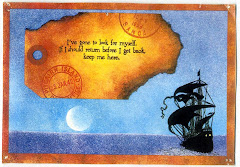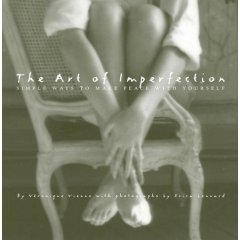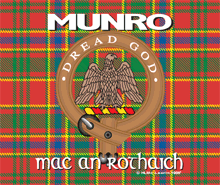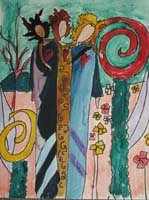 "PORTRAIT OF JOHN KEATS" by William Hilton
"PORTRAIT OF JOHN KEATS" by William HiltonUsually at this time of year, I include John Keats' "Ode to Autumn" in my blog, either a few lines from it, or the entire poem.
"ODE TO AUTUMN" (first verse)
"Season of mists and mellow fruitfulness,
Close bosom-friend of the maturing sun,
Conspiring with him how to load and bless
With fruit the vines that round the thatch-eaves run;
To bend with apples the mossed cottage-trees,
And fill all fruit with ripeness to the core;
To swell the gourd, and plump the hazel shells
With a sweet kernel; to set the budding more,
And still more, later flowers for the bees,
Until they think warm days will never cease,
For Summer has o'er-brimmed their clammy cell."
 This year, I am particularly enthusiastic about lauding the poem, for this autumn season features the release of Jane Campion's long-in-coming new film, "Bright Star", which tells the love story of Keats and young Fanny Brawne.
This year, I am particularly enthusiastic about lauding the poem, for this autumn season features the release of Jane Campion's long-in-coming new film, "Bright Star", which tells the love story of Keats and young Fanny Brawne.Ah, Johnny Keats! If you've ever taken a class in English literature, you know about Keats, one of the famed trio of English Romantic Poets, along with Percy Bysshe Shelly and Lord Byron. You must recognize lines like these:
First verse of "A THING OF BEAUTY" ("ENDYMION"):
"A thing of beauty is a joy for ever:
Its loveliness increases, it will never
Pass into nothingness, but still will keep
A bower of quiet for us, and a sleep
Full of sweet dreams, and health; and quiet breathing..."
First verse of "LA BELLE DAME SANS MERCI"
"Ah, what can ail thee, wretched wight,
Alone and palely loitering?
The sedge is withered from the lake,
And no birds sing. "
Last verse of "ODE ON A GRECIAN URN":
"When old age shall this generation waste,
Thou shalt remain, in midst of other woe
Than ours, a friend to man, to whom thou say'st,
'Beauty is truth, truth beauty,--that is all
'Beauty is truth, truth beauty,--that is all
Ye know on earth, and all ye need to know.' "

The film, told mainly from Fanny's point of view, has gotten generally excellent reviews. Keats, as one reviewer puts it, makes a fine subject for a period romance: " His now-revered poetry was scorned in his lifetime. He was genteel yet poor, dependent on the kindness of his friends. He died young, of tuberculosis (naturally). And the great love of his life was a woman he could never afford to marry."

Keats met Fanny, daughter of his next door neighbor, when he lived in Hampstead Heath, London, with his friend and supporter, Charles Brown. At first, Keats considers Fanny, age 16, to be a little minx, but is clearly captivated by her. She, on the other hand, is unimpressed by his poems. But her willingness to learn about poetry leads to friendship, then a slowly developing romance and finally to a deep ardor.
 In the movie, the love story of John and Fanny is told mainly through conversations about poetry and love letters received by Fanny. Theirs was a very passionate, yet chaste, relationship, never physically consummated. As one reviewer succinctly puts it, they lived in an age hidebound by propriety and social rituals and restraints they were obliged to observe.
In the movie, the love story of John and Fanny is told mainly through conversations about poetry and love letters received by Fanny. Theirs was a very passionate, yet chaste, relationship, never physically consummated. As one reviewer succinctly puts it, they lived in an age hidebound by propriety and social rituals and restraints they were obliged to observe.Their doomed love affair was cut short due less to illness than to his poverty, social mores and the interference of friends. Brown, especially, could not stand Fanny and did everything he could to come between the two.

Keats' began a career as a medical student but as time passed his thoughts turned more and more toward writing poetry. His final years were marked by incredible bouts of creativity - his luminous sonnets and his masterpieces, the odes. Together, they form a body of work that is among the best loved and most popular in English literature.
The movie's title comes from the title of the last poem Keats ever wrote, to and about Fanny:
"BRIGHT STAR" (also known as "HIS LAST SONNET")
"Bright star, would I were stedfast {sic} as thou art--
Not in lone splendour hung aloft the night
And watching, with eternal lids apart,
Like nature's patient, sleepless Eremite,
The moving waters at their priestlike task
Of pure ablution round earth's human shores,
Or gazing on the new soft-fallen mask
Of snow upon the mountains and the moors
No--yet still stedfast, still unchangeable,
Pillow'd upon my fair love's ripening breast,
To feel for ever its soft fall and swell,
Awake for ever in a sweet unrest,
Still, still to hear her tender-taken breath,
And so live ever-or else swoon to death."

Sketch of John Keats by Charles Brown, 1819
First lines of "ODE TO A NIGHTINGALE"
"My heart aches, and a drowsy numbness pains
My sense, as though of hemlock I had drunk,
Or emptied some dull opiate to the drains
One minute past, and Lete-wards had sunk:
'Tis not through envy of thy happy lot
But being too happy in thy happiness,---
That thou, light-winged Dryad of the trees,
In some melodious plot
Of beechen green, and shadows numberless,
Singest of summer in full-throated ease."
**********
Keats' mother died of consumption (tuberculosis), as did his brother Tom, whom John cared for during his illness. Not long after Tom died, John began to show symptoms of the disease. I think this foreknowledge of an early death is especially reflected in this poem:
"WHEN I HAVE FEARS THAT I MAY CEASE TO BE":
"When I have fears that I may cease to be
Before my pen has glean'd my teeming brain,
Before high piled books, in charactry,
Hold like rich garners the full ripen'd grain;
When I behold, upon the night's starr'd face,
Huge cloudy symbols of a high romance,
And think that I may never live to trace
Their shadows, with the magic hand of chance;
And when I feel, fair creature of an hour,
That I shall never look upon thee more,
Never have relish in the faery power
Of unreflecting love; -- then on the shore
Of the wide world I stand alone, and think
Till Love and Fame to nothingness do sink."
**********
With his relationship with Fanny thwarted and his tuberculosis symptoms growing worse, Keats moved to Italy in 1820 in hopes the better climate would lead to a recovery. Instead, he died at age 25 on Feb. 23, 1821, in his home on Rome's Spanish Steps. His last request was that he be buried beneath a tombstone unmarked with his name, carrying only these words: "Here lies one whose name was writ in water."
However, two friends added this epitaph: "This grave contains all that was mortal of A YOUNG ENGLISH POET, who on his death bed, on the bitterness of his heart, of the malicious powers of his enemies {his critics with their scathing attacks} desired these words to be engraved on his tombstone."
Of course, Keats's words were not writ upon water, but stone, and printed upon thousands of book pages. He proved his vicious critics wrong. Their names have been forgotten; his never will. His place in the pantheon of English Romantic poets is assured.
I hope the movie "Bright Star" renews an interest in Keats' poetry and causes his star to shine even brighter in the literary cosmos. Although Fanny may be the bright star of the film, John Keats is the actual bright star - the fixed point around which mere planets orbit.
To read any or all of John Keats' poems in their entirety, go to poemhunter.com and type in his name.
I expect to go to this film over the weekend, if it opens in Bismarck.
~~~~~~~~~~~~~~~~~~~~~~~~~~~
Added Friday afternoon: "Bright Star" isn't opening in Bismarck this weekend, but they are devoting two screens to "Cloudy With A Chance of Meatballs". Stupid town.






























11 comments:
Julie this was wonderful. I'd just posted a snippet about Keats' Ode to Autumn - was thrilled to read so much more. I'll definitely be looking for this movie locally - would love to see it. Had no idea he died at such a young age! How terribly sad.
Thanks as always for beautiful art and words.
Have a fun weekend.
Mary.
Lovely! And, although I hadn't heard about the movie prior, it will now on my list. Thanks for posting and always informing and delighting us!
Just found your blog.....lovely. Looking forward to 'Bright Star'. I'll be back....as Arnie said!
What a fantastic post you've written - thank you. Keats is one of my favourites and it's so lovely to be able to read more here....
I took a romantic lit class way back when I was in college right out of high school. I was in way over my head at the time, but I did try. In fact, I did a paper on Keats and his poetry, not that I can recall much of it now (nor can I recall my paper either). I have to admit that I've never been a fan of poetry. I think partly because it was dissected too heavily in school for so many years and it sucked the joy and life out of the pieces for me. At any rate, Julie, I am so happy to see a new post from you! Did you get my card? Did you see my entry on Blue Willow? I love the shot of Keats' love in the lavender field. So beautiful!!! And I am wondering about Brown's sexual proclivities. It seems he may have had Keats in his own sights.
I just found your beautiful blog while searching for photos and info about the movie "Bright Star" and John Keats. I really want to see the movie too!
And much to my surprise, I noticed you have the tartan of Munro on your page... In researching my family genealogy, I discovered I have Munro relatives from Scotland going back to the 1790s and 1800s.
Thank you for writing such a lovely post!
ps... I have always known I had Scottish ancestors just like you. I even have a Scottish name and red hair! The Scots were mentioned more often by my grandparents, but I also have ancestors from Ireland too. Maybe we are distant relatives or Soul Friends?
this weekend i wanted to stay home but next one i HAVE to go to the movies. i love movies with costumes and hairs all done and prairies and pretty countrysides and poetic so this is gotta be a good one.
Love your new banner Julie!
I have been MIA a lot this summer. So here I am trying to catch up. Love this post...I love period movies.
Speaking of movies. I watched the secret life of Bee's, I thought it was really good.
Fall is in the air, it was almost cold today and my feet are already cold, Happy Fall, Mary
What are those purple flowers on the field in the picture where Fanny was reading Keat's letter?
Those are common, or English, bluebells. Aren't they gorgeous? You can still find whole fields of them in England and Scotland to this day.
Post a Comment